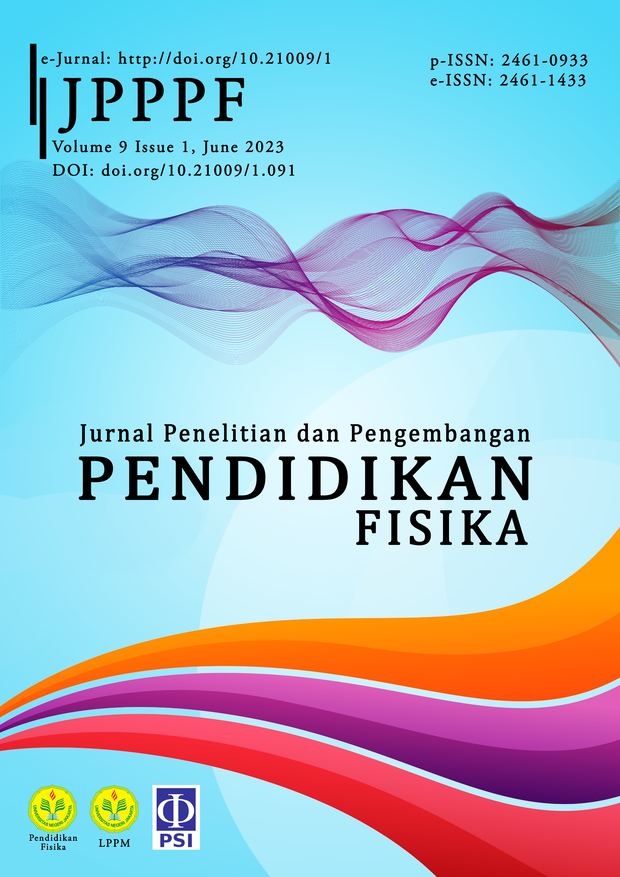Newtonian Yoyo (Lato-Lato) Phenomenon in Indonesia: An Innovative Resource for IGCSE Physics Teaching and Learning?
DOI:
https://doi.org/10.21009/1.09111Keywords:
Newtonian yoyo (lato-lato), IGCSE Physics, learning resourceAbstract
This paper aims to stimulate a teaching and learning reflection for Indonesian IGCSE physics classrooms through a recent booming and recreational game of Newtonian yoyo called lato-lato. As physics is one of the critical and complex subjects in secondary school, it establishes a struggle for students to comprehend the concept of physics. The 21st-century physics education learning aims to promote high-end reasoning and deep understanding. Contextual physic learning will support this mission to reach maximum attainment for students. Physics through contextual knowledge will be more feasible for students. The recent phenomenon of lato-lato encounters a new interest for students. Lato-lato as a demonstrator and contextual example will be a resourceful material for several concepts of Newtonian mechanics, for instance: collision and energy. In addition, lato-lato may provide an advanced idea of circular motion, momentum, and impulse, oscillation. Lato-lato involvement may bring a chance for IGCSE curriculum adjustment in mechanics topics to become a significant pre-learning process. By using the adjusted curriculum, students are more likely to reach their maximum attainment and conceptual understanding of mechanics because students feel interested and encouraged to learn through a problem-solving and real-world setup. Lato-lato (Newtonian Yoyo) phenomenon may solve students’ learning difficulties in IGCSE physics through a conceptual phenomenon.
References
CAIE 2020, ‘Syllabus Cambridge IGCSE Physics 0625’, Cambridge University Press, https://www.cambridgeinternational.org/programmes-and-qualifications/cambridge-igcse-physics-0625.
Gjerde, V, Holst, B & Kolstø, SD 2021, ‘Integrating effective learning strategies in basic physics lectures: A thematic analysis’, Physical Review Physics Education Research, vol. 17, no. 1, https://doi.org/10.1103/PhysRevPhysEducRes.17.010124.
Gutolo, SG & Tekello, KO 2015, ‘Problems in the teaching and learning of physics at the secondary and preparatory schools, the cases wolaita and dwuro zones’, Global Journal of Human-Social Science, Global Journals Inc. (USA), vol. 15, no. 7, pp. 1-5.
Hernandez, C, Ravn, O & Forero-Shelton, M 2014, ‘Challenges in a Physics Course: Introducing Student-Centred Activities for Increased Learning’, In Journal of University Teaching & Learning Practice, vol. 11, no. 2, p. 8, http://ro.uow.edu.au/jutlphttp://ro.uow.edu.au/jutlp/vol11/iss2/8.
Koehler, MJ, Mishra, P, Kereluik, K, Shin, TS & Graham, CR 2014, ‘The technological pedagogical content knowledge framework’, In Handbook of Research on Educational Communications and Technology, Springer New York, pp. 101-111, https://doi.org/10.1007/978-1-4614-3185-5_9.
Kurniawan, DT, Suhandi, A, Kaniawati, I & Rusdiana, D 2017, ‘The Analysis of Learning Obstacle and Students Learning Motivation of Prospective Math Teachers in Basic Physics Class’, Journal of Physics: Conference Series, vol. 812, no. 1, p. 012026, https://doi.org/10.1088/1742-6596/812/1/012026.
Li, Y, Wang, K, Xiao, Y & Wilson, SM 2022, ‘Trends in Highly Cited Empirical Research in STEM Education: a Literature Review’, Journal for STEM Education Research, vol. 5, no. 3, pp. 303-321, https://doi.org/10.1007/s41979-022-00081-7.
Mallari, RL 2020, ‘Students’ Attitudes and Approaches towards Physics Problem Solving: Basis for Intervention Program’, International Journal of Scientific and Research Publications (IJSRP), vol. 10, no. 11, pp. 241-247, https://doi.org/10.29322/ijsrp.10.11.2020.p10728.
Molla, MG 2022, ‘Implementation of Physics Learning by Using the Guided Inquiry Method on the subject matter of Ohm’s Law and Series-parallel Circuits, Effectiveness in terms of Learning Outcomes, Involvement and Constraints’, In International Journal of Basic and Applied Science, vol. 11, no. 1, pp. 1-9, www.ijobas.pelnus.ac.id.
Napsawati & Kadir, F 2022, ‘Analysis of Physics Practicum Problems Faced by Students during Distance Learning’, Jurnal Pendidikan Fisika, vol. 10, no. 1, pp. 58-66, https://doi.org/10.26618/jpf.v10i1.5785.
Panagou, D, Kotsis, KT & Stylos, G 2021, ‘An Empirical Study on the Evolution of Students’ Perceptions in Basic Concepts of Physics of Primary and Secondary Education in Cyprus’, In Electronic Journal For Research In Science & Mathematics Education, vol. 26, no. 2, pp. 91-109, https://ejrsme.icrsme.com/article/view/21441
Punch, K & Oancea, A 2014, ‘Introduction to research methods in education (2nd ed.)’, SAGE Publication.
Putranta, H, Kuswanto, H, Hajaroh, M, Dwiningrum, SIA & Rukiyati 2021, ‘Strategies of physics learning based on traditional games in senior high schools during the Covid-19 pandemic’, Revista Mexicana de Fisica E, vol. 19, no. 1, pp. 1-15, https://doi.org/10.31349/REVMEXFISE.19.010207.
Ramayani, N & Amalia, L 2022, ‘The Analysis of Barriers to the Use of Physics Practicum Applications’, International Journal of Education and Teaching Zone, vol. 1, no. 1, pp. 34-43, https://doi.org/10.57092/ijetz.v1i1.9.
Satriawan, M, Rosmiati, R, Widia, W, Sarnita, F, Suswati, L, Subhan, M & Fatimah, F 2020, ‘Physics learning based contextual problems to enhance students’ creative thinking skills in fluid topic’, Journal of Physics: Conference Series, vol. 1521, no. 2, p. 022036, https://doi.org/10.1088/1742-6596/1521/2/022036.
Serhane, A, Debieche, M, Karima, B & Zeghdaoui, A 2020, ‘Overcoming University Students’ Alternative Conceptions in Newtonian Mechanics’, American Journal of Networks and Communications, vol. 9, no. 2, 22-29, https://doi.org/10.11648/j.ajnc.20200902.12.
Spatz, V, Hopf, M, Wilhelm, T, Waltner, C & Wiesner, H 2020, ‘Introduction to Newtonian mechanics via two-dimensional dynamics-The effects of a newly developed content structure on German middle school students’, In European Journal of Science and Mathematics Education, vol. 8, no. 2, pp. 76-91, https://eric.ed.gov/?id=EJ1252766.
Stylos, G, Evangelakis, GA & Kotsis, KT 2008, ‘Misconceptions on classical mechanics by freshman university students: A case study in a Physics Department in Greece’, Themes in Science and Technology Education, Klidarithmos Computer Books, vol. 1, no. 2, pp. 157-177.
Sunal, DW, Dantzler, JA, Sunal, CS, Turner, DP, Harrell, JW, Simon, M & Aggarwal, MD 2016, ‘The 21st Century Physics Classroom: What Students, Teachers, and Classroom Observers Report’, School Science and Mathematics, vol. 116, no. 3, pp. 116-126.











